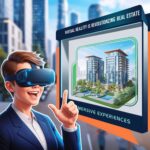Posted inVirtual Reality
How Virtual Reality is Shaping the Real Estate Industry
Virtual reality (VR) is revolutionizing the real estate industry by offering immersive experiences, virtual tours, and interactive property visualizations. It enhances property marketing, streamlines the buying process, and provides remote access to properties, transforming the way real estate is bought, sold, and experienced.

